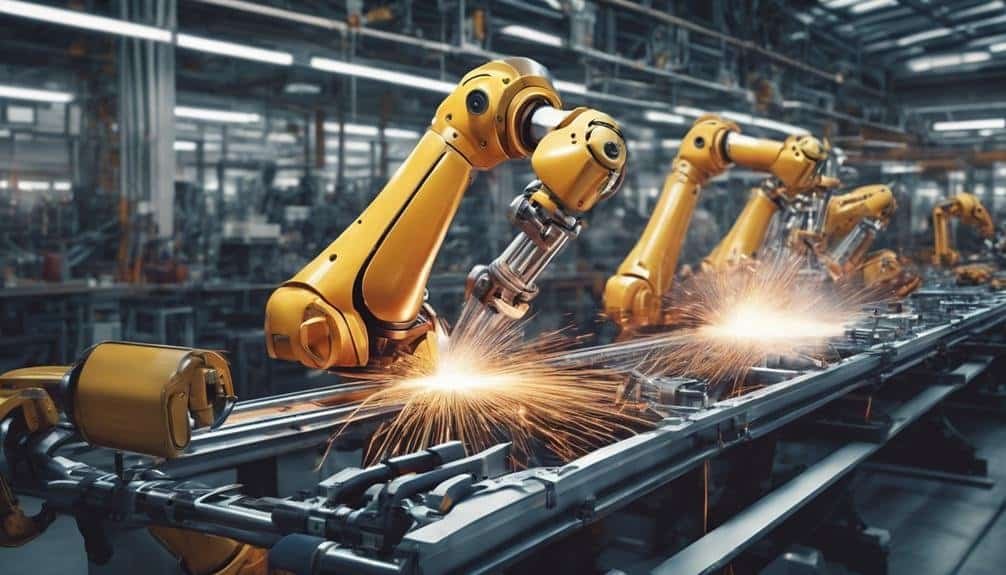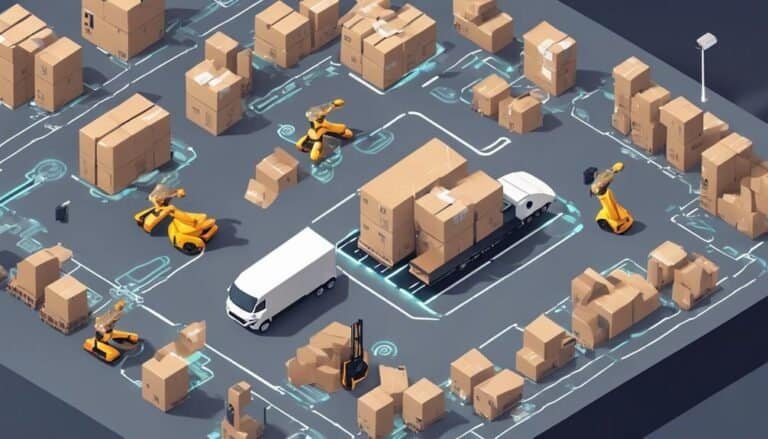Robotics and Automation: A Practical Guide
Are you ready to explore the intricate world of Robotics and Automation?
Unravel the complexities of integrating cutting-edge technologies into everyday processes and witness the transformative power they hold.
From understanding the fundamental principles to navigating the ethical dilemmas, this practical guide will equip you with the knowledge needed to navigate the realm of robotics and automation with confidence.
Key Takeaways
- Understanding basic principles and components of robotics for practical application.
- Implementing robotics solutions like RPA and industrial automation for efficiency gains.
- Industrial automation techniques such as predictive maintenance and real-time monitoring for operational excellence.
- Advancements in robotics and AI integration for enhanced efficiency and decision-making.
Overview of Robotics
If you’re new to robotics, understanding the basic principles and components is crucial for grasping the field’s complexity. Robotics applications span across various industries, including manufacturing, healthcare, agriculture, and even space exploration. These versatile machines are designed to perform tasks autonomously or semi-autonomously, enhancing efficiency and precision in repetitive or hazardous operations.
Robotics technology advancements have revolutionized the way tasks are executed. From simple pick-and-place robots to complex humanoid robots, the capabilities of these machines continue to evolve. Sensors play a vital role in enabling robots to perceive and interact with their environment. Whether it’s a camera for visual recognition or a proximity sensor for obstacle avoidance, these components are integral to the functionality of robots.
Actuators are another essential component in robotics, responsible for executing physical actions. Electric motors, pneumatic cylinders, and hydraulic systems are commonly used actuators that enable robots to move, grip, and manipulate objects with precision. The control system acts as the brain of the robot, processing sensor data and sending commands to the actuators to perform the desired actions.
Understanding the synergy between these components is fundamental in developing efficient and reliable robotic systems. As you delve deeper into the world of robotics, exploring the intricate mechanisms and algorithms that drive these machines, you’ll uncover the endless possibilities and applications that robotics offers.
Benefits of Automation
Exploring the numerous advantages of automation reveals its profound impact on efficiency and productivity across various industries. By incorporating automated systems into your workflow, you can achieve significant benefits such as increased productivity and cost savings. Let’s delve into these advantages in more detail:
| Benefits of Automation | Description |
|---|---|
| Increased Productivity | Automation streamlines processes, reduces manual intervention, and speeds up production cycles. |
| Cost Savings | By automating repetitive tasks, companies can lower labor costs, minimize errors, and save resources. |
Increased productivity is a key advantage of automation. By implementing automated systems, you can streamline processes, reduce the need for manual intervention, and accelerate production cycles. This efficiency boost translates into completing tasks faster and more accurately, ultimately leading to increased output levels.
Cost savings are another significant benefit of automation. With automated processes in place, companies can lower labor costs by relying less on manual work. Additionally, automation helps minimize errors and reduce waste, leading to savings in resources and materials. Overall, embracing automation can result in substantial cost reductions and improved profitability for businesses in various industries.
Types of Robots
When categorizing robots, it’s essential to understand the distinct types that serve various functions in different industries. Robots come in different forms to fulfill specific tasks efficiently.
Robotic companionship is a growing field where robots are designed to provide companionship and assistance to individuals. These robots are often used in healthcare settings or with the elderly to offer company and support. On the other end of the spectrum, military robotics are used for surveillance, reconnaissance, and even combat operations. These robots are equipped with advanced technology to navigate challenging terrains and perform tasks in dangerous environments.
Household robots are becoming increasingly popular, helping with tasks like cleaning, cooking, and even home security. These robots aim to simplify daily chores and improve the quality of life for homeowners. Autonomous vehicles represent a significant advancement in robotics, with self-driving cars leading the way. These vehicles use sensors and artificial intelligence to navigate roads safely without human intervention.
Understanding the different types of robots is crucial for selecting the right technology for specific applications. Whether it’s for companionship, military operations, household chores, or transportation, each type of robot plays a vital role in advancing automation across various industries.
Implementing Robotics Solutions
When implementing robotics solutions, you’ll focus on Robotic Process Automation (RPA) and Industrial Automation Solutions.
RPA involves automating repetitive tasks using software robots to streamline operations.
Industrial Automation Solutions encompass the use of robotic systems in manufacturing processes to increase efficiency and productivity.
Robotic Process Automation
To successfully implement robotics solutions for Robotic Process Automation, meticulous planning and precise execution are essential. When diving into this domain, focus on the following key aspects:
- Process Optimization: Identify areas within your current processes that can be streamlined or improved through automation. This step is crucial in ensuring that the robotic solutions bring maximum efficiency gains.
- Workflow Automation: Map out the entire workflow to understand where automation can be seamlessly integrated. Look for repetitive tasks or manual processes that can be automated to enhance productivity.
- Data Integration: Ensure seamless integration of data sources with the robotic systems. This step is vital for smooth operation and accurate decision-making within the automated processes.
Industrial Automation Solutions
Industrial Automation Solutions employ robotics technology to enhance efficiency and productivity in various industrial processes. Smart factories leverage automated systems to streamline operations, reduce human error, and optimize production outputs. These solutions encompass a range of robotics applications, from automated assembly lines to robotic material handling.
By integrating robotics into manufacturing environments, companies can achieve increased precision, faster cycle times, and improved quality control. Industrial robots are programmed to perform repetitive tasks with consistency and accuracy, freeing up human workers for more complex and value-added activities. The seamless interaction between robots and automated systems ensures a synchronized workflow, leading to enhanced overall operational efficiency.
Implementing robotics solutions in industrial automation paves the way for a future where technology drives productivity to new heights.
Industrial Automation Techniques
Implementing advanced control algorithms can significantly enhance the efficiency and precision of manufacturing processes in industrial automation techniques.
When looking to optimize processes and overcome automation challenges, there are several key techniques that can be employed:
- Predictive Maintenance: By utilizing sensors and data analytics, predictive maintenance can anticipate machinery failures before they occur. This proactive approach minimizes downtime and increases overall equipment effectiveness.
- Real-time Monitoring and Control: Implementing real-time monitoring systems allows for instant feedback on production processes. This enables quick adjustments to be made in response to changing conditions, ensuring consistent quality and efficiency.
- Integration of Internet of Things (IoT): Connecting machinery and devices through IoT technologies enables seamless communication and data exchange. This integration facilitates the automation of tasks such as inventory management, scheduling, and quality control, streamlining operations and reducing manual intervention.
Robotics in Manufacturing
As you explore the realm of robotics in manufacturing, you’ll encounter the pivotal role played by automated assembly lines in enhancing efficiency. These systems are meticulously designed to streamline production processes and minimize human intervention, ensuring a consistent output.
The integration of robotics in manufacturing not only boosts productivity but also allows for precision and accuracy in the assembly of complex products.
Efficiency in Production
To enhance production efficiency in manufacturing processes, integrating robotics technology is crucial. By incorporating robots into your production line, you can significantly increase productivity and reduce waste. Here’s how robotics can help:
- Precision and Consistency: Robots can perform tasks with incredible precision and consistency, leading to higher quality products and reducing the margin of error.
- Faster Production Cycles: With the ability to work continuously without breaks, robots can speed up production cycles, maximizing output in a shorter amount of time.
- Adaptability and Flexibility: Modern robots are designed to be easily reprogrammable, allowing for quick changes in production processes to meet varying demands efficiently.
Automated Assembly Lines
Automated assembly lines revolutionize manufacturing processes by seamlessly integrating robotics technology to streamline production operations. These systems enhance efficiency through automated quality control mechanisms that ensure precision and consistency in output.
In sectors like food processing, robotics play a vital role in maintaining high standards of sanitation and safety. Smart manufacturing principles drive the development of these assembly lines, enabling real-time monitoring and adaptive responses to optimize workflow.
Additionally, robotic maintenance techniques are implemented to proactively address issues and minimize downtime, further enhancing productivity. The seamless integration of robotics in automated assembly lines not only improves operational efficiency but also ensures a high level of product quality and compliance with industry standards.
Automation in Agriculture
In modern agriculture, the integration of advanced robotics and automation technologies has revolutionized farming practices. Farmers now have access to precision farming techniques that allow for more efficient use of resources and increased crop yields. Smart agriculture solutions have also been instrumental in monitoring and managing crops, livestock, and equipment with greater accuracy.
Key Aspects of Automation in Agriculture:
- Precision Farming Techniques: Utilizing technologies like GPS, drones, and sensors, farmers can analyze data on soil conditions, weather patterns, and crop health to optimize the use of water, fertilizers, and pesticides. This targeted approach ensures that resources are applied only where and when needed, reducing waste and environmental impact.
- Smart Agriculture Solutions: Through the integration of Internet of Things (IoT) devices and data analytics, farmers can remotely monitor and control various farming operations. Automated systems can regulate irrigation, adjust feeding schedules for livestock, and even detect crop diseases early on, allowing for timely interventions and higher productivity.
- Automated Harvesting Systems: Robotics and automation have also revolutionized the harvesting process. Machines equipped with computer vision and robotic arms can pick fruits and vegetables at the right ripeness, sort produce based on quality, and pack them efficiently, saving time and labor costs while ensuring consistent product quality.
Robotics and AI Integration
Utilizing cutting-edge technologies and advanced algorithms, the seamless integration of robotics and artificial intelligence (AI) in various industries has significantly enhanced operational efficiency and productivity. AI-driven robotics applications have revolutionized tasks across sectors, from autonomous vehicles in transportation to robotic process automation in manufacturing. These applications leverage AI algorithms to enable robots to perceive their environment, make decisions, and adapt their actions accordingly, leading to more sophisticated and efficient automation systems.
| Integration Challenges | Solutions |
|---|---|
| Data Compatibility | Develop standardized data formats |
| Interoperability Issues | Implement communication protocols |
| Scalability Concerns | Utilize modular and flexible systems |
| Security Risks | Employ robust encryption and authentication |
Integration challenges often arise due to differences in data formats, communication protocols, and scalability issues. To tackle these challenges, implementing standardized data formats, communication protocols, modular systems, and robust security measures is crucial. By addressing these integration hurdles, organizations can ensure a smooth and effective collaboration between robotics and AI technologies, leading to optimized operations and enhanced performance. The synergy between robotics and AI continues to evolve, offering new possibilities for automation and efficiency across diverse industries.
Challenges in Automation
Challenges in automation present intricate hurdles that demand strategic solutions for streamlined operational efficiency. When navigating the realm of robotics advancements and automation, it’s crucial to be aware of potential obstacles that may arise. Here are some key challenges in automation along with their corresponding solutions:
- Integration Complexity: One major hurdle in automation is the complexity of integrating different systems and technologies. Diverse hardware and software components often need to work together seamlessly, requiring meticulous planning and testing. To address this challenge, companies can invest in comprehensive compatibility assessments before implementing new automation solutions.
- Data Security Risks: With the increased reliance on interconnected systems, the risk of data breaches and cyber-attacks also rises. Protecting sensitive information and ensuring the security of automated processes is paramount. Implementing robust encryption protocols, regular security audits, and employee training on cybersecurity best practices can help mitigate these risks.
- Skill Gaps and Workforce Training: As automation technologies evolve, there’s a growing need for skilled professionals who can design, implement, and maintain these systems. Addressing the skill gaps through specialized training programs, upskilling existing employees, and fostering a culture of continuous learning can help organizations overcome this challenge and fully leverage the benefits of automation.
Robotics in Healthcare
Now, let’s explore the cutting-edge applications of robotics in healthcare.
Surgical robots offer precise incisions and minimally invasive procedures.
Artificial intelligence enhances patient care through data analysis and personalized treatment plans,
while advancements in robotic prosthetics are revolutionizing the field of rehabilitation.
Surgical Robots Benefits
Surgical robots offer precise control and enhanced dexterity during delicate procedures, significantly reducing the margin of error in healthcare settings. These benefits are particularly evident in precision surgery and minimally invasive techniques.
Here are three key advantages of using surgical robots:
- Enhanced Precision: Surgical robots can make extremely precise movements, allowing for accurate incisions and suturing in tight spaces.
- Reduced Trauma: By enabling minimally invasive procedures, surgical robots can reduce the trauma experienced by patients, leading to quicker recovery times.
- Improved Visualization: Many surgical robots are equipped with high-definition cameras that provide surgeons with detailed, real-time visuals of the operating area, enhancing overall precision and decision-making during surgery.
AI in Patient Care
Utilizing artificial intelligence in patient care enhances the efficiency and accuracy of healthcare delivery through advanced robotic technologies. AI plays a crucial role in patient monitoring by analyzing vast amounts of data in real-time, enabling healthcare providers to make informed decisions promptly.
Robotics in telemedicine further revolutionizes patient care by allowing remote consultations, diagnosis, and treatment planning. These robotic systems facilitate virtual interactions between healthcare professionals and patients, ensuring timely access to medical expertise regardless of geographical barriers.
Robotic Prosthetics Advancements
In the realm of healthcare robotics, the field of robotic prosthetics is witnessing significant advancements that are reshaping the landscape of patient care and rehabilitation.
- Bionic Limbs Evolution: Modern prosthetics now incorporate advanced materials and designs, allowing for more natural movements and increased durability.
- Sensory Feedback Advancements: Innovations in sensory feedback systems enable users to experience a sense of touch and pressure, enhancing their control and interaction with the prosthetic limb.
- Customization and Personalization: Robotic prosthetics are becoming more personalized to meet individual needs, with features like adjustable grips and tailored movement patterns, improving comfort and functionality for users.
These developments are revolutionizing the field of prosthetics, offering enhanced capabilities and improving the quality of life for individuals with limb loss.
Automation in Logistics
Implementing automated processes in the logistics sector significantly enhances efficiency and streamlines operations. Warehouse optimization plays a crucial role in this automation trend by utilizing technologies like automated storage and retrieval systems (AS/RS) to maximize storage capacity and improve inventory management. These systems efficiently handle goods, minimizing human intervention and reducing errors in picking and storing items. By automating repetitive tasks such as inventory counting and sorting, warehouses can operate with higher accuracy and speed, ultimately leading to cost savings and improved customer satisfaction.
Supply chain automation further complements warehouse optimization by integrating automated processes across the entire logistics network. Automated order processing, for instance, speeds up order fulfillment and reduces lead times. This streamlined approach minimizes bottlenecks in the supply chain and ensures timely delivery of goods to customers. Additionally, automated transportation management systems optimize routes, reduce fuel consumption, and enhance overall fleet efficiency. Real-time tracking and monitoring of shipments provide visibility into the supply chain, allowing for quick adjustments to ensure on-time deliveries.
Robotics Programming Basics
When approaching the topic of Robotics Programming Basics, you should first understand the Code Fundamentals Overview. This entails grasping the essential building blocks that form the backbone of robot programming.
Next, it’s crucial to compare Programming Languages to determine the most suitable option for your specific robotic application.
Code Fundamentals Overview
Explore the foundational principles of programming essential for robotics and automation systems.
When delving into robotics programming, understanding key concepts is crucial. Here are essential elements to grasp:
- Variable Declaration and Data Types:
- Variables store data, while data types define the kind of data a variable can hold.
- Examples include integers (whole numbers) and strings (text).
- Conditional Statements:
- These allow the program to make decisions based on conditions.
- If-else statements are common in robotics programming.
- Loops:
- Loops repeat a block of code until a certain condition is met.
- For loops and while loops are fundamental for executing repetitive tasks efficiently.
Programming Languages Comparison
Comparing programming languages for robotics involves evaluating their syntax, performance capabilities, and compatibility with hardware interfaces.
In the realm of robotics programming, Python and C++ are widely used languages. Python’s simplicity and readability make it a preferred choice for rapid prototyping and development.
C++, on the other hand, offers better performance and is commonly used for applications requiring real-time processing.
When it comes to automation implementation, Java and Rust are popular choices.
Java provides platform independence and a vast array of libraries, suitable for developing automation systems.
Rust, known for its safety features and high performance, is gaining traction in industries where reliability and speed are critical factors for automation projects.
Debugging Common Errors
To effectively troubleshoot common errors in robotics programming, meticulous attention to code structure and logic is paramount. When facing issues, follow these steps for effective error diagnosis, troubleshooting, and resolution:
- Review Error Messages: Pay close attention to any error messages or warnings provided by the programming environment. They often give clues about what went wrong.
- Check Input Data: Verify that sensor inputs, variables, and user inputs are correctly handled. Incorrect data handling is a common source of errors.
- Step through Code: Use debugging tools to step through the code line by line. This helps in identifying the root cause of the issue and finding a resolution efficiently.
Future Trends in Robotics
In the rapidly evolving field of robotics, upcoming advancements are poised to revolutionize the way tasks are automated and executed. Robotics in space exploration is expected to reach new heights as robots play a crucial role in missions to distant planets, conducting experiments, collecting samples, and even constructing habitats.
The future of autonomous vehicles is also promising, with self-driving cars becoming more prevalent, leading to safer and more efficient transportation systems.
In the realm of education, robotics is increasingly being integrated into classrooms to enhance learning experiences. Robots are used to teach various subjects, promote problem-solving skills, and foster creativity among students. This hands-on approach not only makes learning more engaging but also prepares students for future careers in fields like engineering and programming.
The impact of 5G on robotics can’t be underestimated. The ultra-fast speeds and low latency of 5G networks enable robots to communicate and process data in real-time, enhancing their capabilities in various applications such as healthcare, manufacturing, and logistics. This technology paves the way for more interconnected and responsive robotic systems, opening up new possibilities for automation in diverse industries. As robotics continues to advance, these trends promise to shape the future of automation in profound ways.
Ethical Considerations in Automation
Navigating the complex landscape of automation, ethical considerations play a pivotal role in ensuring responsible and conscientious deployment of robotic systems. As technology advances, it’s essential to address ethical dilemmas and moral implications that arise from the integration of automation in various industries. Here are three key points to consider:
- Job Displacement: One of the primary ethical dilemmas in automation is the potential impact on employment. Introducing robotic systems that can perform tasks traditionally done by humans may lead to job displacement. It’s crucial to ethically manage this transition by upskilling workers, providing retraining programs, or creating new job opportunities to mitigate the social consequences of automation.
- Data Privacy and Security: Automation often involves the collection and processing of vast amounts of data. This raises concerns about data privacy and security. Companies must prioritize ethical practices by ensuring that data is handled responsibly, transparently, and securely. Implementing robust data protection measures and complying with relevant regulations are essential to address these moral implications.
- Algorithmic Bias: Automation systems rely on algorithms to make decisions. However, these algorithms can inherit biases present in the data used to train them, leading to discriminatory outcomes. Recognizing and mitigating algorithmic bias is critical to ensure fair and just outcomes in automated processes. Ethical considerations must drive the development and deployment of algorithms to prevent perpetuating social inequalities.
ROI of Robotics Integration
When considering the return on investment (ROI) of integrating robotics into your operations, it is crucial to analyze the cost-benefit implications meticulously. The cost analysis should encompass not only the initial investment in robotics systems but also ongoing maintenance, training, and potential downtime costs. On the other hand, profitability assessment involves forecasting the potential increase in productivity, efficiency gains, and labor cost savings that robotics integration can bring to your operations.
To provide a clearer picture, below is a table outlining key factors to consider when evaluating the ROI of robotics integration:
| Factors to Consider | Description |
|---|---|
| Initial Investment | Includes costs of purchasing robotic systems, installation, and any required infrastructure |
| Maintenance Costs | Ongoing expenses for upkeep, repairs, and software updates |
| Training Needs | Costs associated with training employees to operate and maintain the robotics systems |
| Productivity Gains | Potential increase in output, efficiency, and quality due to automation |
Conclusion
As you navigate the intricate world of robotics and automation, remember this: while the benefits of increased efficiency and productivity are undeniable, ethical considerations must always be at the forefront of your decision-making process.
Balancing the advantages of automation with the potential consequences is key to ensuring a successful integration of robotics solutions.
Stay vigilant, stay informed, and always prioritize the well-being of both your business and society as a whole.







